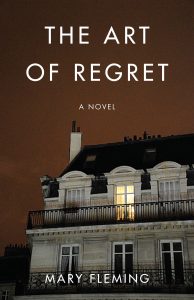This Parisian Life
 Every morning in Paris I walk my dog across the Seine and look up river. On the horizon stands the Notre Dame Cathedral, until recently the spire pointing to the sky. In my mind’s eye she looms larger in the vista than she does in real life but that is surely due to her outsized place in the city’s persona. Because when I imagine Paris, where I have lived well over half my life, I see a refined, elegant lady. The lady is Notre Dame; the city her abundant, richly-layered skirts.
Every morning in Paris I walk my dog across the Seine and look up river. On the horizon stands the Notre Dame Cathedral, until recently the spire pointing to the sky. In my mind’s eye she looms larger in the vista than she does in real life but that is surely due to her outsized place in the city’s persona. Because when I imagine Paris, where I have lived well over half my life, I see a refined, elegant lady. The lady is Notre Dame; the city her abundant, richly-layered skirts.
The fire that ravaged the 850-year grande dame last April 15th shocked and saddened the world but it also felt very personal, as if a dear friend were on the brink of death. It reminded me that Paris herself was one reason I started writing seriously.
When I arrived at age 24 to marry a British man I had met during a junior year abroad in England, my first priority was finding work that paid. That led to some strange jobs to which I was not particularly well-suited—the back office of an investment bank, a weekly telecommunications newsletter produced by a manic man. I wrote articles for an English-language magazine and did some freelance consulting. I did research for The New Yorker correspondent. On the side I wrote snatches of stories that I had trouble finishing.
Then came the children—one, two, three—and a steadier job representing a Washington, DC-based foundation. I began finishing some of my short stories and sending them (unsuccessfully) to magazines. I got divorced and remarried, gaining two stepsons along the way. With now five children, a lawyer husband who worked 80-hour weeks and travelled constantly and my own job requiring more and more time on the road, something (someone) had to give.
It was quite happily me because by then I wanted to try writing a novel. Paris herself was a motivation. While I’d been running around for meetings, taking my children to school or visiting friends over the years, I’d got to know her distinctive quartiers well.
By then too I’d lived in quite a few of them and each left its mark. First there was a modern block in the 13th arrondissement, right next to Chinatown and above a noisy school courtyard. It had floor heating and zero charm. After that came a 17th century garret in the Latin Quarter with lots of charm (huge wooden beams and a fireplace) but frigid tiled floors and mice. I never took off my thickest-soled shoes and we got a cat. Next came another 300-year old building just streets away that was both charming and comfortable but not big enough to accommodate a new baby.
That led to a fortunately short stint in the farther-flung 16th arrondissement. In a19th century building, it was cramped and on the sixth floor with no elevator. I do not remember how I got both a heavy baby and the shopping up all those stairs but I do remember getting tendonitis in my forearm. Isabelle the cat, accustomed to going out and exploring interior courtyards, didn’t like it either. She would jump out windows and wander along the gutters, almost causing my heart to fail every time.
We scurried back to the Latin Quarter, this time to the 5th rather than the 6th arrondissement, to live in a former convent. The ground-floor apartment had been the refectory for the nuns. It had huge arched windows and gave onto a garden where the children could play and the cat could once again explore. It was heaven on earth but not a big enough paradise for a recomposed family of seven. I moved to the very bourgeois but central 7th arrondissement, to a Haussmann-style apartment with three living rooms but only one bathroom the size of a closet. In fact the place had no closets and I remember feeling like a squirrel, my things stuffed in furniture drawers all around the apartment.
After that came the place down the street where I have now lived for over 20 years. It’s close to the banks of the Seine and the Tuileries gardens, where I walk the dogs that succeeded Isabelle the cat. Besides lots of closets and enough bathrooms to accommodate the whole family, the apartment came with a chambre de service, a room on the top floor of the building where the domestic help used to live but that I could use as my office, a place to write. Like something out of a story itself, the room has a door to the roof with a 360° view of Paris; it was from there that I watched Notre Dame burn.
It was in that office that I began to write my first novel and in a way I wrote it in homage to Paris herself. To the skirts of Notre Dame that had given me my own rich accumulation of memories.
Surroundings are important to any story and I have been lucky with mine. But any setting can be used to good effect. Think of Kafka’s “Metamorphosis” where Gregor Samsa barely leaves his bedroom. Most of Hemingway’s The Old Man and the Sea takes place on a boat. The important thing is to ground a story in a place that rings true in your own imagination.
—
Mary Fleming, originally from Chicago, moved to Paris in 1981, where she worked as a freelance journalist and consultant. Before turning full-time to writing fiction, she was the French representative for the American foundation The German Marshall Fund. A long-time board member of the French Fulbright Commission, Mary continues to serve on the board of Bibliothèques sans Frontières. Having raised five children, she and her husband now split their time between Paris and Normandy. THE ART OF REGRET is her second novel. She writes a blog called A Paris-Perche Diary at https://mf.ghost.io/. Her website is https://www.maryfleming.co/.
 Trevor McFarquhar lives a controlled, contrary existence. Traumatized by early childhood loss, the silence surrounding those losses, and then a sudden family relocation from the United States to France, he has no ambitions or dreams for his struggling Parisian bicycle shop or even for himself. Now in his late thirties, his romantic relationships are only casual―his friendships, few. He’s both aloof and exacting, holding everyone to his own high standards while being unforgiving of their faults.
Trevor McFarquhar lives a controlled, contrary existence. Traumatized by early childhood loss, the silence surrounding those losses, and then a sudden family relocation from the United States to France, he has no ambitions or dreams for his struggling Parisian bicycle shop or even for himself. Now in his late thirties, his romantic relationships are only casual―his friendships, few. He’s both aloof and exacting, holding everyone to his own high standards while being unforgiving of their faults.
But then two things happen. The 1995 transit strike forces Parisians through Trevor’s shop door to procure bicycles, and his once-sluggish business suddenly turns around. To his surprise, he is pleased. At the same time, Trevor enters into a relationship that threatens to destroy his relationship with his entire family. Humbled and ashamed, his veneer cracks, and he emerges from his cocoon a different man, ready to reconnect, to rediscover possibility, and ultimately to redeem himself.
Category: Contemporary Women Writers, On Writing
























